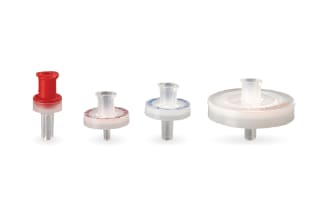Laboratory Filters
The right lab filter for any sample type
Sample and solvent filtration is a preventative maintenance procedure that saves labs time and money. Laboratory filtration products can help minimize downtime by providing immediate protection for the column and instrumentation components. With Pall Life Sciences Filters from Waters, you can confidently meet your regulatory and quality objectives with lab filters that have been designed, developed, and certified for compliance.
With our broad range of Pall laboratory filters, your lab can access a range of different membranes for solvent and sample compatibility, as well as a variety of devices for various filtration applications. To choose the right filter for your lab, consider sample characteristics, volume, and pore size, then decide if the sample may require prefiltration because it is laden with particulate matter.
Specifications
Overview
- Save money and prevent downtime due to contamination with HPLC sample filters in syringe filter format
- Achieve solvent and sample compatibility with HPLC solvent filters in membrane disc format
- Easily perform vacuum filtration of liquids and degassing of HPLC solvent and mobile phases with the solvent filtration apparatus
Recommended Use: Pall Laboratory products are designed for laboratory applications only. These products are not approved for use in medical, clinical, surgical, or other patient applications.
Laboratory Filter Membrane Choices
-
Designed specifically to extend the lifespan of LC columns used for LC-MS analyses without adding significant extractables and with minimal analyte adsorption
-
Constructed with a water-wettable polytetrafluoroethylene (wwPTFE) membrane in high density polyethylene (HDPE) housings
-
All-purpose water wettable, hydrophilic, polytetrafluoroethylene membranes
-
Designed for aqueous, acidic, basic, non-aggressive organic, and aggressive organic solutions
-
Offers low protein binding and low levels of UV-absorbing extractables
-
Hydrophilic membrane that works well with both aqueous and organic solvents
-
Particularly suitable for high-pH samples but should be avoided in any protein recovery applications
-
Designed with a glass fiber prefilter over the membrane for hard to filter samples laden with particulate matter
-
Can be used alone or as a prefilter with another Acrodisc in series
-
Hydrophilic polyvinylidene fluoride (PVDF) membranes good for aqueous and organic solvents
-
Hydrophobic, polytetrafluoroethylene (PTFE) membranes recommended for use with non-aqueous solvents
-
Organic-based, highly acidic or basic samples and solvents
-
Polyethersulfone (PES) IC filters are certified to contain low ionic backgrounds for ion chromatography
Concerned about particulate matter in your sample?
Step 1: Determine the nature of your sample
Identifying the right lab filter is a 3-step process. Begin selecting your lab filter by determining the nature of your sample with the guidelines below:
- Aqueous: wwPTFE, Nylon, PVDF, and Supor PES
- Non Polar: CR/PTFE, wwPTFE, and MS PTFE
- Protein: wwPTFE and GH PVDF
- Ion Chromatography: Supor PES
Step 2: Identify your column particle size
The micron size of the particles in your column matter. After determining your sample nature, match your column to the filter with these guidelines:
Micron size >3 µm: filter pore size of 0.45 µm - HPLC
Micron size <3 µm: filter pore size of 0.20 µm - UPLC
Step 3: Determine your sample volume
Finally, consider the volume of your sample to identify the right lab filter for your needs.
- Sample volume <2 mL: 4 mm filter and <10 µL hold up volume
- Sample volume <10 mL: 13 mm minispike and <14 µL hold up volume
- Sample volume <10 mL: 13 mm male Luer and <30 µL hold up volume
- Sample volume <100 mL: 25 mm filter and <100 µL hold up volume
